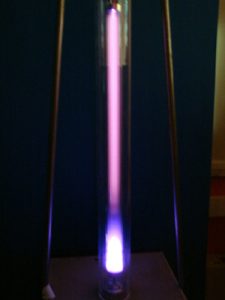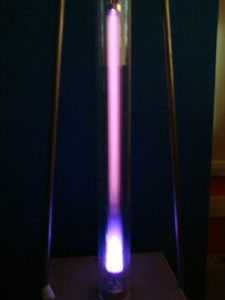 |
 |
The three states of matter with which you are familiar are solid, like ice or iron, liquid, like water and gaseous like air. Matter in all these states is composed of small particles called atoms. This exhibit displays the creation of a fourth state of matter: Plasma, a gas in which some of the atoms are broken up into free floating electrons (-) and positive ions (+), atoms that have lost electrons and are left with a positive charge. Plasma is quite common in nature. The sun is a plasma ball of great density, auroras (northern lights) are very low density plasmas, the fluorescent lights you use in the house contain a plasma.
THE APPARATUS
Notice the vertical glass tube, it is connected to a vacuum pump which can remove most of the air in it. The tube has a metal disc negative (-) electrode (the cathode) at the bottom and a positive one (+) (the anode) at the top. A large plastic tube protects the glass. The big round dial on the front measures the amount of air pressure left in the tube, it is now showing full (15 pounds per square inch), the same pressure of the air as in the room. Patm = 15 lb/in2 The small square dial above it on the right tells how many kilo (thousands of) Volts are on the electodes (kV). The next dial shows how many milli (thousandth of) Amperes of electrical current is going through the tube (mA). To the left of that is a dial that measures the amounts of air too small to show on the big dial; it is marked in Microns or millionths of full normal pressure.
DO
Press the red “start” button.
An electric valve has shut the tube off from the room and started a pump, you can hear it chugging away, and can watch the pressure diminishing in the big dial.The electrode voltage is turned on, the voltage meter shows 20kV.
NOTHING SEEMS TO BE HAPPENING!
Voltage is applied to the gas (air here) in the tube but no current is flowing: at normal room pressure air does not conduct electricity.
BE PATIENT
In about five minutes, when just a little air is left in the tube suddenly the tube lights up, we have a plasma.
WHY?
Air, or any gas for that matter consists of atoms, tiny particles too small to see, all bouncing around, off each other and off the walls. These particles can be thought of as made up of positive parts, (positive ions) and negative parts (electrons) held together by the attraction due to their opposite polarities.
Now a few atoms break apart by themselves and soon reassemble but while they are apart the electrons start heading for the positive electrode and the ions toward the negative one. While the pressure is high these fragments do not get very far before they bump into a nearby atom and are sent off in another direction before they get up much speed. As more and more air is pumped away, and atoms are less crowded, and these loose electrons and ions can fly farther and get up more speed before hitting an atom harder.
Eventually these collisions are hard enough to knock more electrons off, and make more electron-ion pairs, which then do more of the same and the process multiplies. The ions that are drawn to the negative disk (the cathode) hit it hard enough to knock electrons of its surface and provide a source of electrons heading for the positive disc (the anode) through the gas. This avalanche process sets in quite suddenly and the tube light up with plasma.
WHY THE LIGHT?
Not every collision is hard enough to free up new electrons, indeed some electrons bump into ions softly and stick there to form complete atoms, As these atoms settle back to form normal atoms they get rid of any excess energy that was brought in by the captured electron by releasing a photon,The higher energy photons are wave packets with a short wavelength that corresponds to violet visible light. The lower energy photons produce light of intermediate colours from blue, green, yellow, orange and red.
DO
A magnet hangs from the exhibit, use it in the vicinity of the plasma tube. See how the magnetic field influences the motion of the moving electric charges in the plasma.
WHY THE DIFFERENT COLORS?
Not every re-assembled atom gets the same amount of energy from its new electron. In some regions along the plasma column electrons get a longer or shorter flight before sticking to an atom, so they bring more or less extra energy for their atoms to get rid of. This way in different regions different colors of photons are given off.
The exact reasons why each region glows a particular color as more and more gas is removed, are a quite complex and are still being studied in plasma physics after more than a century.